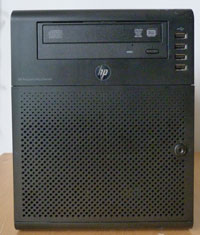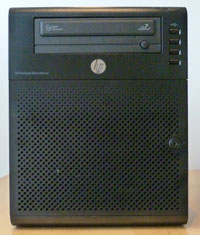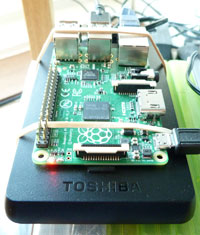The Server
I always find it interesting to see
what hardware delivers a website to my screen,
and since this is a site about home servers here is a tour of my home
server setup.
Since starting I've used dozens of computers as home servers, mostly cheap
second hand desktop machines purchased on eBay that satisfied my performance
needs at the time but with no overhead for the future. For my current servers I
decided to invest in decent machinery that was designed to be a server and would
last well into the future.
Server 1:
HP Microserver N54L
Acquired in June 2015 to run alongside my other server below and handle all
internet related tasks, keeping my data and backups separate to websites for
security. To keep costs down I chose a second hand Gen 7 HP Microserver over a
new machine and from my other server I knew they were reliable and suited my
requirements. This cost £180 for all the specs listed with the exception of the
two WD Green drives I had spare.
This machine runs Windows 2012 R2 and runs Web, Download, Remote and a bit of
Storage services.
 |
Processor: AMD Athlon™ II Neo N54L 2.2Ghz Dual Core |
|
Memory: 4GB (1 x 4GB) PC3-10600E DDR3 UnBuffered ECC |
|
Network: Embedded NC107i PCI Express Gigabit Ethernet Server |
|
Network: HP Intel 82574L PCI Gigabit Ethernet Adapter |
|
Storage Controller: Embedded SATA Non Hot swap |
|
Hard Drive: 2x1TB Westen Digital Caviar Green SATA II on RAID1 |
|
Hard Drive: 2x2TB Seagate ST2000D 7200rpm SATA II on RAID1 |
|
Optical Drive: HP GH82N 16x DVD-RW DL & RAM SATA |
|
Power Supply: 150W Non-Hot Plug, Non-Redundant |
|
Operating System: Windows Server 2012 R2 Standard |
Server 2:
HP Microserver N36L
Purchased from new in April 2011, this machine spent four years as my main
server, taking care of all server roles, web, media, download and backup.
Originally started as a stock system with added 2 x 1TB WD Green drives in RAID
1 as storage and the original 250GB drive as boot, later upgrading to 4GB RAM
and an additional 2 x 2TB drives in RAID 1, moving the 1TB drives to boot
partition. Original cost of the system came in at £240.
Running Windows Server 2003 R2 it has been a very reliable server, with the only
downtime as a result of my careless actions. However since Win 2003 finished its
extended support phase from Microsoft, it's roles have been downgraded to just
media and backup.
 |
Processor: AMD Athlon™ II Neo N36L 1.3Ghz Dual Core |
|
Memory: 4GB (2 x 2GB) PC3-10600E DDR3 UnBuffered ECC |
|
Network: Embedded NC107i PCI Express Gigabit Ethernet Server |
|
Storage Controller: Embedded SATA Non Hot swap |
|
Hard Drive: 2x1TB Westen Digital Caviar Green SATA II on RAID1 |
|
Hard Drive: 2x2TB Westen Digital Caviar Green SATA II on RAID1 |
|
Optical Drive: Samsung SH-S223 22x DVD±RW DL & RAM SATA |
|
Power Supply: 150W Non-Hot Plug, Non-Redundant |
|
Operating System: Windows Server 2003 R2 Enterprise |
Server 3:
Raspberry Pi B+
In operation since September 2014, this is my second Raspberry Pi, the first was
intended as a learning and server system but quickly became a media player once
I found out its capabilities. This Pi however is functioning as a learning tool
for Linux by running Raspbian (Debian Wheezy), running in most part as a Usenet,
Torrent and http download server, as well as a web server for testing and
whatever else I like to try. The OS runs off a 8GB micro SD card while data is
saved on a Toshiba Stor.e 1TB drive connected and powered by USB.
 |
Processor: Broadcom ARM11 SOC 700mhz |
|
Memory: 512MB SDRAM |
|
Network: Embedded 10/100 Base T Ethernet |
|
Hard Drive: Sandisk 8GB Micro SD Card (Boot) |
|
Hard Drive: Toshiba Stor.E Basics 1TB via USB |
|
Power Supply: Generic 5 Volt 2 Amp USB Micro B |
|
Operating System: Linux Debian 7 Wheezy |